Basketball Court Lighting Retrofit
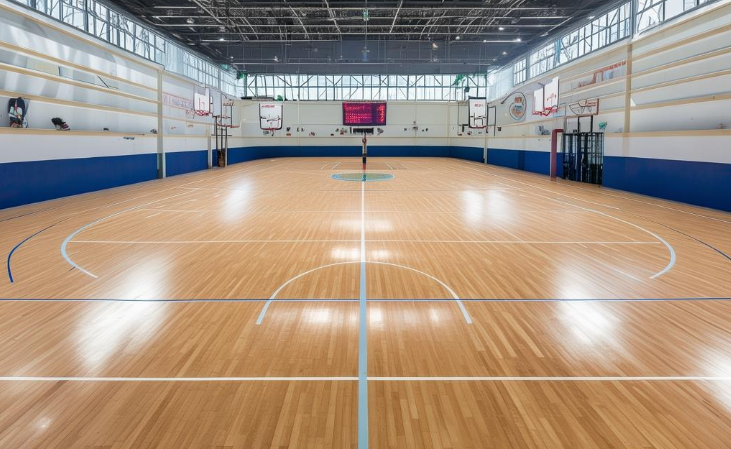
Directory:
1. Field Survey Calculation
2. DIALux Software Simulation
3 Scene Lighting Design
A contemporary basketball court needs not only an attractive design and comprehensive sports facilities but also an effective lighting setup. The lighting design should take into account three key factors:
(1) it must fulfill the visual needs of athletes during competitions while minimizing any adverse effects of lighting on the game;
(2) it should cater to the visual comfort of spectators, reducing any discomfort caused by the lighting while they watch;
(3) it must meet the lighting standards for video broadcasts to enhance broadcast quality. This paper addresses the lighting issues of a basketball court at a specific university. It employs DIALux software to determine the optimal number of light sources, their distribution, and layout methods to simulate and calculate the lighting for basketball courts with various functions, ultimately identifying the best solution for lighting retrofit.
1. Field Survey Calculation
The actual venue and its CAD drawing are depicted in the figure below. Using the four-corner point method for the illumination test, the basketball playing area is divided into a rectangular grid. After activating the flood lights at night, the illuminance at the four corners of the grid is measured with a TES1330A illuminance meter, resulting in a maximum illuminance of Emax=510 lx, a minimum of Emin=140 lx, an average of Eh=316 lx, and an illuminance uniformity of U1=Emin/Emax=0.27. The uniformity U2=Emin/Eh=0.44. Comparing these results that while the pre-retrofit lighting meets basic requirements, it is inadequate for basketball games. There are inconsistencies in illumination both vertically and horizontally, with areas that are excessively bright or dark, failing to provide optimal visual conditions for players, spectators, and referees.
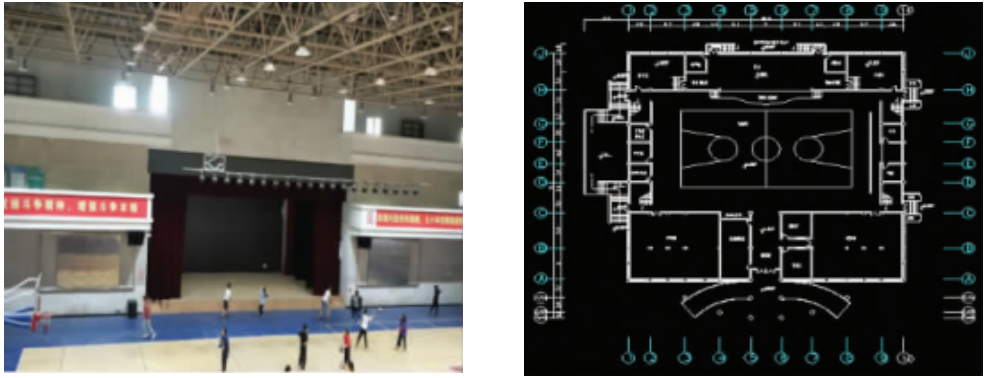
The dimensions of the basketball court were measured using a laser theodolite, and a CAD layout of the gymnasium was created. The court measures 40 m in length, 30 m in width, and 11.5 m in height, conforming to the design standards for Class II indoor sports facilities.
2. DIALux Software Simulation
The CAD drawing was imported into DIALux software, where the actual venue was selected to create a 3D model of the basketball court, as illustrated in the figure below. The venue serves multiple purposes, featuring a stage at the front and seating and aisles at the back. It can accommodate rehearsals, physical training, and both general and professional basketball games. Consequently, this paper will focus on lighting retrofits tailored to these three scenarios. The gymnasium's decorative elements are included in the model but do not interfere with the calculations or final illumination measurements.
3. Scene Lighting Design
Sports lighting must create an optimal visual environment for athletes, referees, and spectators. Various lighting techniques can be employed, including strip lighting on both sides, star-shaped lighting, and mixed lighting. Typically, basketball courts utilize metal halide lamps or high-power LED lamps. This article carefully selects different types of lighting based on the specific requirements of various settings.
3.1 Rehearsal Program and Daily Physical Training Scene
The star-shaped lighting technique, which provides uniform lighting from above, is an effective lighting solution for smaller multi-purpose stadiums. It is particularly suitable for venues with limited space, high demands for horizontal illumination uniformity, and no television broadcast requirements. This lighting system allows athletes to easily track the ball's direction and speed, as well as the quick movements of other players. The even arrangement of lights ensures good spatial illumination and uniformity, which are crucial for stadium lighting design. The original venue has a height of 11.5 meters, with a 2-meter high bracket ceiling installed. Consequently, all lamps are mounted on the ceiling in the lighting design. The starry sky lighting method was chosen for the rehearsal program and daily training scene. After comparing lighting parameters, conducting simulation calculations, and adhering to standards, the final selection included 15 LED downlights, each with a power of 200 W, a luminous flux of 21.000 lm, a color temperature of 4.000 K, a color rendering index of Ra80+, an 80° beam angle, and a hanging height of 2 meters, featuring a symmetrical appearance and light distribution curve. The lighting position, retrofit effects, and simulation calculation results are illustrated in the figure below. The average illuminance (Eh) is 349 lx, exceeding the national standard of 300 lx, with a uniformity ratio (U2) of Emin/Eh=0.85. which is significantly higher than the national standard of 0.3. The lighting retrofit for the daily training scene has been deemed successful.
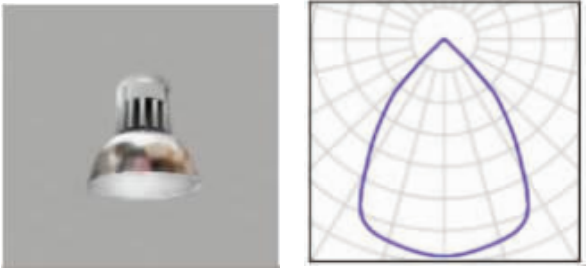
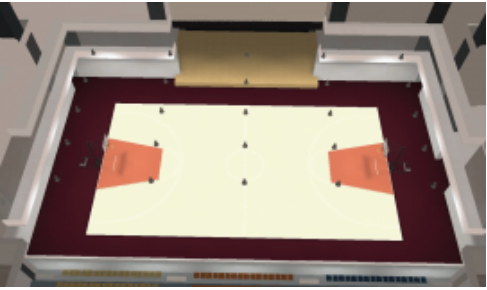
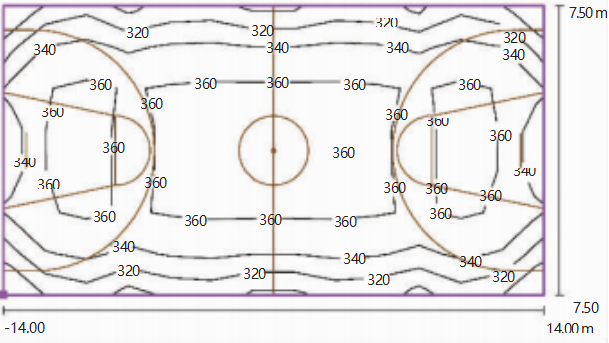
3.2 General and Professional Competition Lighting
To enhance the lighting for both general and professional competition settings, the starry sky lighting technique and dual-side strip lighting method are incorporated alongside the existing daily training lighting. The dual-side strip lighting involves positioning lamps in rows along both sides of the court, creating a continuous light strip system. This method ensures uniform illumination and optimal brightness for both athletes and the court, making it suitable for professional events.
3.2.1 General Competitions
After extensive adjustments, simulations, and standard comparisons, an additional 10 LED downlights, each with a power of 150 W and a luminous flux of 15.500 lm, have been integrated into the existing uniform overhead lighting. The other specifications remain consistent with the previous fixtures, as illustrated in the accompanying diagram. The solid point indicates the original 200 W LED locations, while the center point marks the new 150 W LED placements.

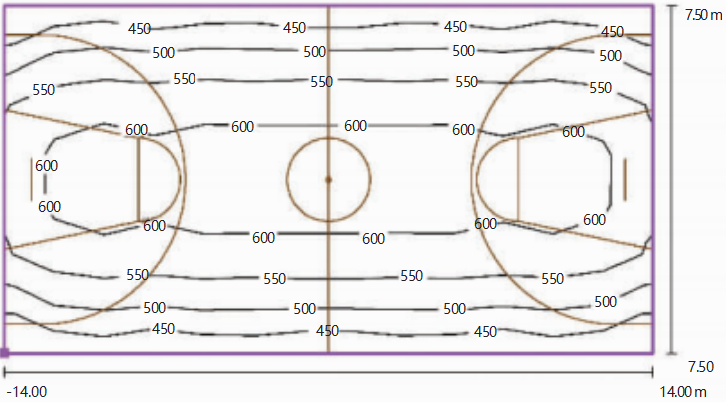
3.2.2 Professional Competition Lighting
Following continuous adjustments, simulations, and standard comparisons, the existing overhead lighting has been enhanced with dual-side strip lighting. This includes the addition of 28 projection lamps, each with a power of 80 W and a luminous flux of 7.500 lm, installed on both sides of the basketball court. These lamps have a color temperature of 4.000 K, a color rendering index of Ra80+, and a beam angle of 80 degrees, with a hanging height of 2 meters.

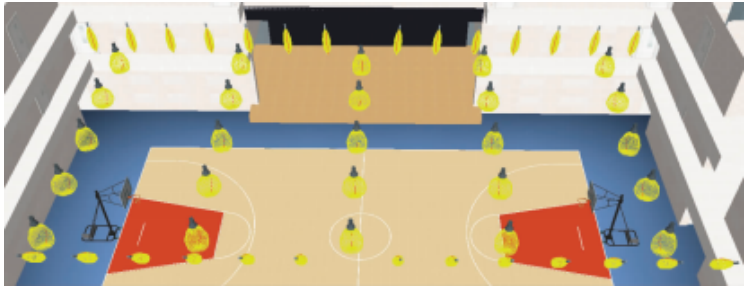
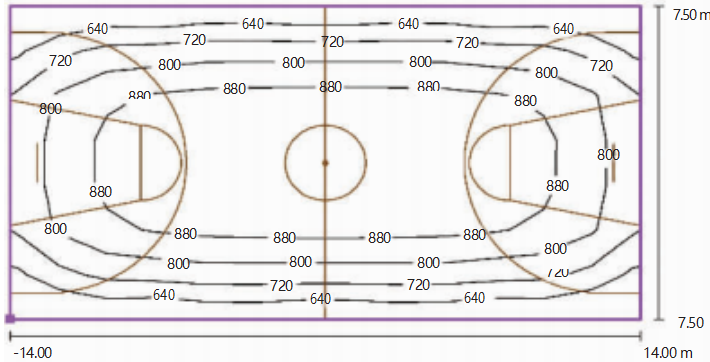
By integrating various lighting methods and fixtures, the lighting effect in the basketball court has been accurately replicated, meeting the design and testing standards for sports venues. The retrofit has effectively addressed the lighting requirements for daily training, general competitions, and professional events, making it highly appealing to clients.